Breakfast in Japan is typically a light meal that includes rice, miso soup, and a variety of side dishes such as grilled fish, pickled vegetables, eggs, and nori (dried seaweed). Some people might also have natto (fermented soybeans) or tofu. In addition, Japanese people often have a bowl of rice porridge called “okayu,” and green tea to drink.
Breakfast in Japan is usually simple and focuses on traditional, healthy foods to start the day. However, the exact breakfast items and the way they are prepared can vary greatly depending on regional and personal preferences.
Japanese Breakfast Cookbook Check Latest Price
Check Latest Price
Japanese people typically eat the following items for breakfast on a regular basis:
- Rice: A staple food in Japan, rice is often served as part of the main course for breakfast.
- Miso Soup: A light, flavorful soup made from fermented soybean paste and other ingredients like seaweed and tofu.
- Fish: Grilled or broiled fish, such as salmon or mackerel, is a common breakfast food in Japan.
- Eggs: Boiled, fried, or scrambled eggs are often included in a Japanese breakfast.
- Pickled Vegetables: These are usually served as a side dish, along with the rice and soup, to add flavor and nutrition to the meal.
- Nori: Dried seaweed sheets that are often used to wrap rice balls or as a topping for rice.
- Natto: Fermented soybeans that have a strong, pungent flavor and are often served with rice.
- Tofu: Soft, silken tofu is sometimes included in a Japanese breakfast, either as a side dish or as an ingredient in soup.
These are some of the most common foods that Japanese people eat for breakfast on a regular basis, but the exact items may vary depending on personal preferences and regional differences.
Why is Japanese breakfast so healthy?
Japanese breakfast foods can be considered healthy for many people, as they are based on traditional, whole foods that are rich in nutrients and low in processed ingredients. Rice, miso soup, and side dishes such as grilled fish, pickled vegetables, and eggs provide a balanced combination of carbohydrates, protein, and healthy fats.
However, like with any type of food, it’s important to keep in mind individual dietary needs and restrictions, such as allergies or intolerances, when deciding whether Japanese breakfast foods are healthy for you. Additionally, some of the breakfast foods, such as natto and pickled vegetables, can have a strong flavor that may not be to everyone’s liking.
 Check Latest Price
Check Latest Price
It’s always a good idea to speak with a healthcare provider or a registered dietitian if you have concerns about your diet and want to ensure you are getting the right nutrients to meet your needs.
What are the ingredients in Japanese miso soup?
Japanese miso soup typically consists of the following ingredients:
- Dashi: A clear, flavorful broth made from simmered fish and seaweed, which forms the base of the soup.
- Miso paste: Fermented soybean paste that gives the soup its signature flavor and richness. Different types of miso paste, such as red or white miso, can be used to create different flavor profiles.
- Tofu: Soft, silken tofu is often diced and added to the soup for additional protein and texture.
- Wakame: Dried seaweed that is rehydrated and added to the soup for flavor and nutrition.
- Scallions: Thinly sliced green onions that are added for flavor and color.
These are the core ingredients in Japanese miso soup, but other ingredients such as mushrooms, carrots, or clams can sometimes be added to vary the flavor and texture. The exact ingredients used in a particular miso soup recipe can vary greatly depending on regional and personal preferences.
What is natto and Why do Japanese people eat natto?
Natto is a traditional Japanese food made from fermented soybeans. It has a strong, pungent odor and a sticky, stringy texture that is often described as “slimy.” Natto is typically served with rice and is known for its health benefits, as it is high in protein, fiber, and various vitamins and minerals.
In Japan, natto is a popular food and has been part of the country’s cuisine for hundreds of years. It is often consumed for breakfast or as a snack, and is considered a nutritious food that is good for digestion and overall health. Natto is also believed to have anti-inflammatory properties and to be beneficial for cardiovascular health.
Some people enjoy the unique flavor and texture of natto, while others find it unappetizing. Whether or not someone likes natto is often a matter of personal preference, and it may take some time to get used to the strong, pungent flavor and slippery texture. However, for those who enjoy it, natto is a staple food that is highly valued for its health benefits and flavorful taste.
What Is Soy Sauce In Japanese
Soy sauce in Japanese is called “shoyu”. It is a staple condiment in Japanese cuisine, used to enhance the flavor of various dishes, such as sushi, soup, and rice. Japanese soy sauce is made from fermented soybeans, wheat, salt, and water, and has a rich, savory flavor that is used to balance the flavors in a dish and add a subtle umami taste.
Japanese soy sauce is a key ingredient in many traditional dishes, and is also widely used as a dipping sauce and marinade. The flavor and quality of Japanese soy sauce can vary greatly depending on the brand and the method of production, with some artisanal soy sauces being highly prized for their depth of flavor and complexity.

